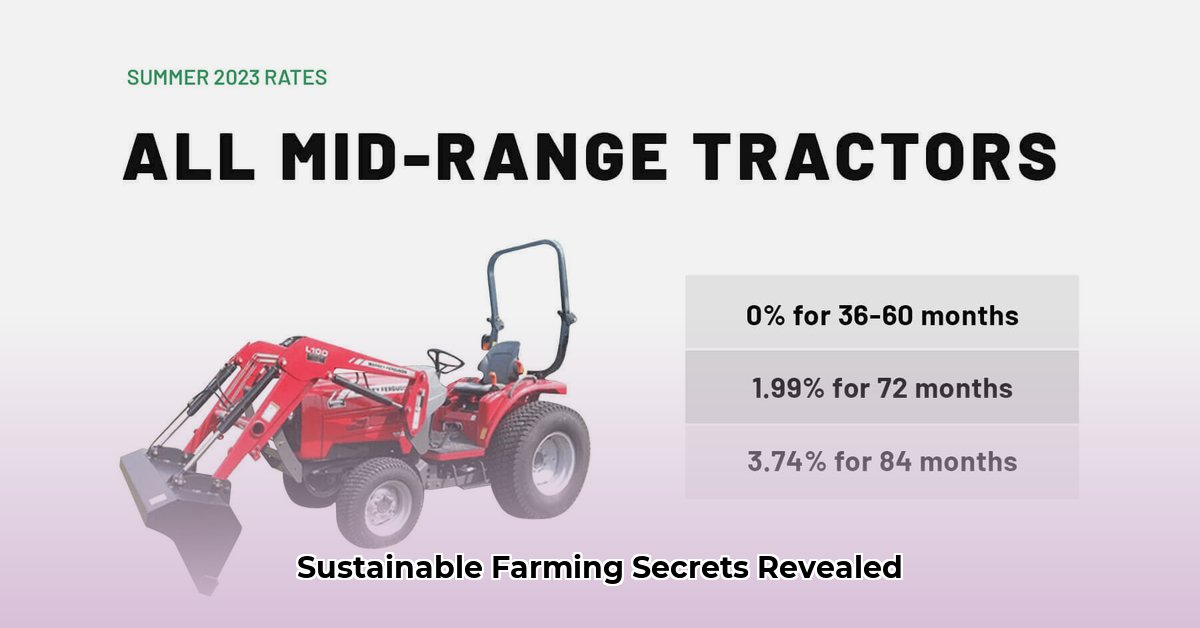
Jim's Tractor: A Gallipolis Case Study
Jim's Tractor, a longstanding equipment supplier in Gallipolis, Ohio, primarily stocks traditional farming machinery. However, the increasing demand for sustainable agricultural practices presents both a challenge and a significant market opportunity. This case study analyzes Jim's current position, the regional context of sustainable agriculture, and outlines actionable steps for transitioning towards a more environmentally friendly business model. The core question this study addresses is: How can Jim's Tractor, and local farmers, capitalize on the growing market for sustainable agricultural equipment? For smaller farms, consider smaller tractors.
The Current State of Affairs: Tradition and the Seeds of Change
Jim's Tractor's current inventory heavily features established brands like Massey Ferguson, New Idea, and Farmhand. This indicates a strong existing market for conventional equipment in Gallipolis. However, a review of their website reveals a notable absence: limited information on sustainable agricultural technologies. This gap suggests a potentially untapped market for environmentally conscious farming solutions. Could this be due to a lack of awareness among local farmers regarding sustainable options or a hesitancy to adopt new technologies? This remains a crucial area for further investigation.
Gallipolis and Sustainable Agriculture: The Local Landscape
Gallipolis's location along the Ohio River presents unique environmental challenges and opportunities. Responsible water management is paramount for the region's agricultural sustainability. Therefore, adopting sustainable farming techniques – such as precision agriculture (using technology to optimize resource use) and reduced-till farming (minimizing soil disturbance) - is crucial for maintaining agricultural productivity while protecting the valuable Ohio River ecosystem. The question remains: How receptive are local farmers to adopting these practices?
Market Opportunities: Sustainable Solutions in Demand
The current market data on sustainable agricultural equipment sales in Gallipolis is limited. To accurately assess the demand, further research is necessary, preferably through comprehensive surveys targeting local farmers. Such surveys could gauge farmers' interest in sustainable equipment, identify their primary concerns (e.g., cost, technological complexity, yield uncertainty), and uncover their preferred resource acquisition channels (e.g., direct dealership purchases, leasing options). Understanding these dynamics is critical for informing Jim's Tractor's strategic investments.
Actionable Recommendations: A Roadmap for Success
The successful transition to sustainable agriculture in Gallipolis requires a collaborative approach involving Jim's Tractor, local farmers, and state governmental agencies. The following recommendations provide a practical roadmap for navigating this complex transition:
For Jim's Tractor:
- Conduct Farmer Surveys: Implement comprehensive farmer surveys to gauge perceptions and needs regarding sustainable farming equipment. Incorporate qualitative data alongside quantitative metrics to create a thorough understanding of local farmer sentiments.
- Expand Inventory: Partner with manufacturers of sustainable agricultural equipment to diversify product offerings, catering to a broader spectrum of farmer needs and budgets.
- Enhance Expertise: Provide training and workshops on the effective use of sustainable farming practices and available equipment. This could include demonstrations, hands-on sessions, and expert-led advice.
For Local Farmers:
- Conduct Cost-Benefit Analysis: Evaluate the financial viability of adopting sustainable practices and equipment. Consider potential long-term savings on inputs, reduced environmental impact, and potential for premium pricing of sustainably produced crops.
- Explore Funding Opportunities: Investigate and apply for relevant grants, subsidies, and low-interest loans offered by state and federal agencies (e.g., the USDA, Ohio Department of Agriculture).
- Invest in Training: Participate in training programs and workshops focused on acquiring the necessary skills and knowledge for adopting sustainable farming practices.
For the Ohio State Government:
- Incentivize Transition: Implement policies and financial incentives (e.g., tax breaks, grants) designed to expedite the adoption of sustainable farming practices.
- Support Research and Development: Fund research into sustainable agriculture methods specifically tailored to the Ohio River Valley's environmental conditions.
- Streamline Regulations: Clarify and streamline regulations related to sustainable agricultural practices to optimize efficiency and ease compliance for farmers.
Risk Assessment: Mitigating Potential Challenges
The transition to sustainable agriculture presents certain risks, including high initial investment costs and potential yield uncertainties during the initial transition period. A robust risk mitigation strategy is paramount:
| Risk Factor | Likelihood | Impact | Mitigation Strategy |
|---|---|---|---|
| High Initial Investment Costs | High | High | Secure financing through grants, loans, leasing programs, and phased implementation. |
| Potential Yield Reduction | Medium | Medium | Implement robust soil management techniques, diversify crop types, utilize precision agriculture. |
| Lack of Farmer Familiarity | Medium | Medium | Invest in comprehensive training programs and hands-on demonstrations. |
| Market Volatility | Low | Medium | Diversify crop offerings, explore direct-to-consumer marketing channels. |
Regulatory Considerations: Navigating Legal Landscapes
Compliance with Ohio state and federal regulations pertaining to pesticide use, water management, and other environmental standards is crucial. Staying informed about and adhering to these regulations is vital for maintaining legal compliance and promoting sustainable agricultural practices. The Ohio Environmental Protection Agency (EPA) website serves as a primary resource for information on these regulations.
Conclusion: Securing a Sustainable Agricultural Future
The future of agriculture in the Gallipolis region depends on embracing sustainable practices. By actively pursuing these recommendations, Jim's Tractor can not only contribute to environmental stewardship, but also position itself as a leader in a growing market for environmentally conscious solutions. Continued research and collaboration between stakeholders are critical for navigating the complexities of this transition and realizing the long-term benefits of sustainable agriculture in the Gallipolis region.